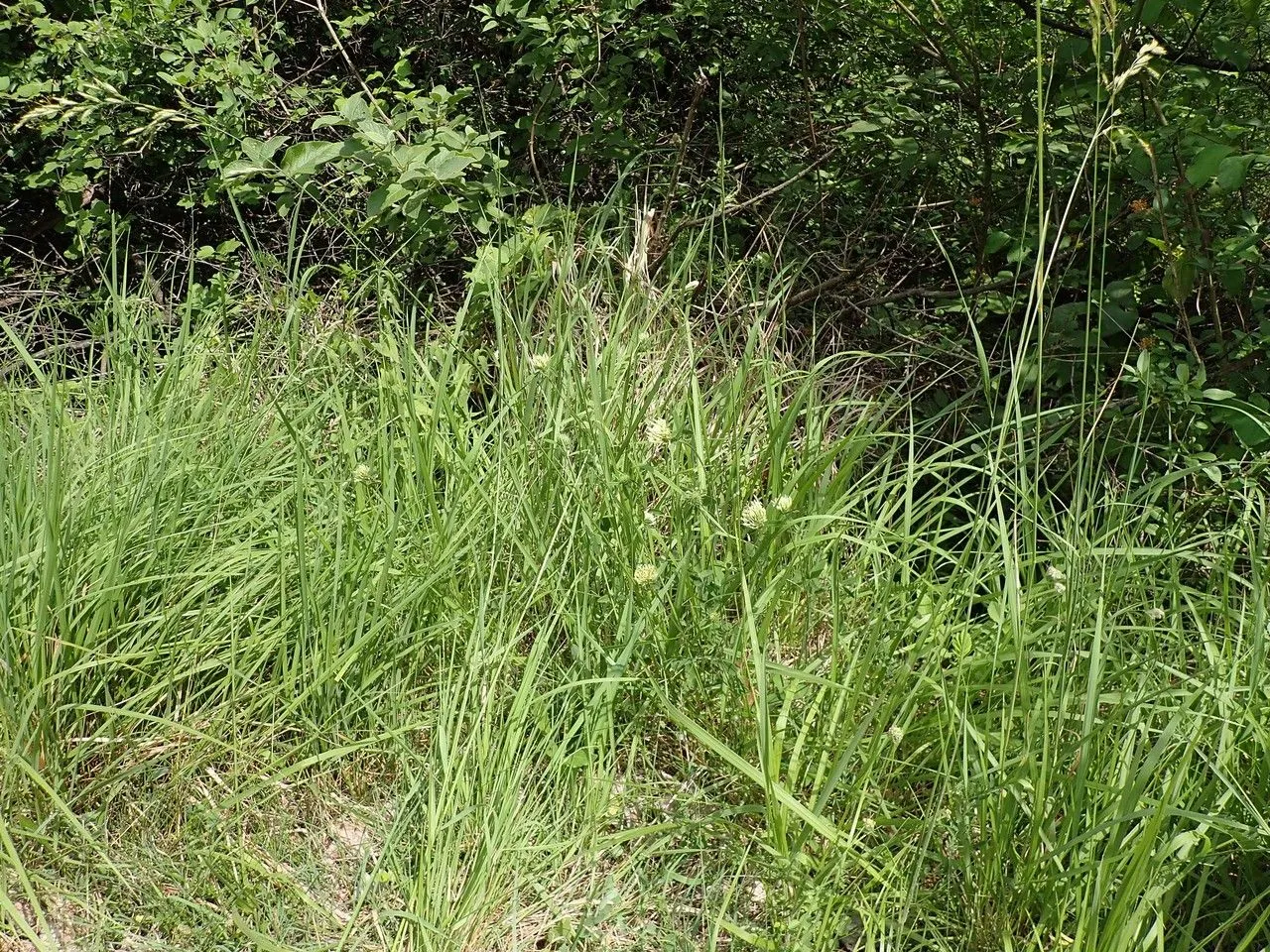
Author: Huds.
Bibliography: Fl. Angl.: 283 (1762)
Year: 1762
Status: accepted
Rank: species
Genus: Trifolium
Vegetable: False
Observations: Europe to Iran, NW. Africa
Sulphur clover, known scientifically as Trifolium ochroleucon, is a perennial plant belonging to the Fabaceae family. This species was first documented in 1762 by the botanist Huds. It is a distinctive member of the clover genus, recognized for its unique flowering characteristics.
Sulphur clover is notable for its pale yellow to cream-colored flowers, which distinguish it from other clover species with typically red or white blooms. The flower heads are dense and globular, consisting of multiple florets. These blooms are often a magnet for pollinators, contributing to the plant’s role in supporting local ecosystems.
The plant has a robust, upright growth habit and can reach a height of 30 to 50 centimeters. The leaves are trifoliate, meaning they are composed of three leaflets, a common trait among members of the clover genus. Each leaflet is oblong and finely toothed, presenting a soft texture on its surface.
Sulphur clover thrives in a variety of habitats across its expansive range. From the grassy meadows and open woodlands of Europe to the more arid regions extending to Iran and Northwest Africa, this plant is highly adaptable. Its presence in diverse climates speaks to its resilience and ability to prosper in different environmental conditions.
As a member of the Fabaceae family, sulphur clover plays a critical role in nitrogen fixation, enhancing soil fertility. This biochemical process involves converting atmospheric nitrogen into a form that plants can assimilate, thus enriching the soil and promoting healthier plant communities. This characteristic makes sulphur clover an invaluable component of natural and agricultural systems.
While not as commonly utilized as other clover species, sulphur clover still holds value in traditional and modern applications. Its leaves and flowers have been used in herbal remedies, owing to their mild astringent properties. Additionally, the plant can serve as forage for livestock, although it is less favored compared to red and white clover varieties.
Currently, sulphur clover does not face any major threats and is not listed as endangered. Its widespread distribution helps ensure that the species remains stable across its range. However, like many wild plants, it could be susceptible to habitat loss and environmental changes caused by human activities.
Trifolium ochroleucon, or sulphur clover, is a remarkable plant that combines ecological significance with unique botanical features. Its adaptability across a broad range and its role in supporting both pollinators and soil health highlight the importance of preserving such species in our natural landscapes.
Deu: blassgelber klee, gelblichweißer klee
Dan: bleggul kløver
Eng: sulphur clover
Cat: trèvol ocroleuc
Nld: geelwitte klaver
Swe: blekklöver
Cym: meillion gwelw, meillionen felenwelw, meillionen welw
En: Sulphur clover
Ar: نفل كبريتي
Bg: Бледожълта детелина
Ca: Trèvol ocroleuc
Cs: Jetel bledožlutý
Da: Bleggul Kløver
Nl: Geelwitte klaver
Fi: Kalvasapila
Fr: Trèfle jaunâtre, Trèfle beige, Trèfle jaune pâle
De: Gelblichweisser Klee, Blassgelber Klee, Gelblichweißer KLee, Blaßgelber Klee, Gelblicher Klee
Is: Skuggasmári
It: Trifoglio bianco-giallo
Pl: Koniczyna żółtobiała
Sv: Blekklöver
Cy: Meillionen welw, Meillion Gwelw, Meillionen Felenwelw
Taken Jul 15, 2007 by Photoflora – Jean-Luc TASSET (©)
Taken May 15, 2009 by Photoflora – Benoit BOCK (©)
Taken Jan 1, 1970 by Photoflora – L’Abbé COSTE (©)
Taken May 11, 2018 by Tela Botanica − Yves PENIT (cc-by-sa)
Taken May 24, 2020 by Sylvain Piry (cc-by-sa)
Taken May 24, 2020 by Sylvain Piry (cc-by-sa)
Taken Jul 5, 2020 by Alain Bigou (cc-by-sa)
Taken Jun 13, 2021 by Михаил Михаил (cc-by-sa)
Taken Jun 13, 2021 by Михаил Михаил (cc-by-sa)
Taken May 28, 2017 by Yoan MARTIN (cc-by-sa)
Taken May 28, 2017 by Yoan MARTIN (cc-by-sa)
Taken Jul 5, 2020 by Alain Bigou (cc-by-sa)
Taken May 24, 2020 by Sylvain Piry (cc-by-sa)
Taken May 28, 2017 by Yoan MARTIN (cc-by-sa)
Taken Jul 18, 2022 by Jacques Zuber (cc-by-sa)
Taken Jun 21, 2007 by Martin Bishop (cc-by-sa)
Taken Jun 4, 2022 by Jean-Marie Frenoux (cc-by-sa)
Taken May 28, 2017 by Yoan MARTIN (cc-by-sa)
Taken Jul 5, 2020 by Alain Bigou (cc-by-sa)
Taken May 24, 2020 by Sylvain Piry (cc-by-sa)
Taken Jun 4, 2019 by Tela Botanica − Michel Gaubert (cc-by-sa)
Taken May 28, 2017 by Yoan MARTIN (cc-by-sa)
Taken Apr 26, 2022 by Patrice Bracquart (cc-by-sa)
Taken Oct 14, 2022 by Patrice Bracquart (cc-by-sa)
Taken Jul 15, 2003 by Photoflora – Jean-Luc TASSET (©)
© copyright of the Board of Trustees of the Royal Botanic Gardens, Kew.
© copyright of the Board of Trustees of the Royal Botanic Gardens, Kew.
© copyright of the Board of Trustees of the Royal Botanic Gardens, Kew.
Light: 8
Family: Myrtaceae Author: (F.Muell.) K.D.Hill & L.A.S.Johnson Bibliography: Telopea 6: 402 (1995) Year: 1995 Status:…
Family: Rubiaceae Author: Pierre ex A.Froehner Bibliography: Notizbl. Bot. Gart. Berlin-Dahlem 1: 237 (1897) Year:…
Family: Sapindaceae Author: Koidz. Bibliography: J. Coll. Sci. Imp. Univ. Tokyo 32(1): 38 (1911) Year:…
Family: Asteraceae Author: A.Gray Bibliography: Pacif. Railr. Rep.: 107 (1857) Year: 1857 Status: accepted Rank:…
Family: Fabaceae Author: Medik. Bibliography: Vorles. Churpfälz. Phys.-Ökon. Ges. 2: 398 (1787) Year: 1787 Status:…
Family: Aspleniaceae Author: (Cav.) Alston Bibliography: Bull. Misc. Inform. Kew 1932: 309 (1932) Year: 1932…